Road Trip through the Rhône Valley
The Rhône Valley is a place of remarkable beauty and astonishing diversity, a patchwork landscape woven together by a common thread: its legendary wines. Jennifer Ladonne gets a taste of the area between Lyon and Avignon
Giving oneself just a week to cover the Rhône Valley – or at least the incredibly varied 140-mile stretch between Lyon and Avignon – is potentially a fool’s errand. My ideal week off here would be to hunker down in a village and decide each morning where to explore. So covering this entire area, which spans seven départements and encompasses must-see sites dating from prehistory to the present day, in only seven days, would leave no time for wandering.
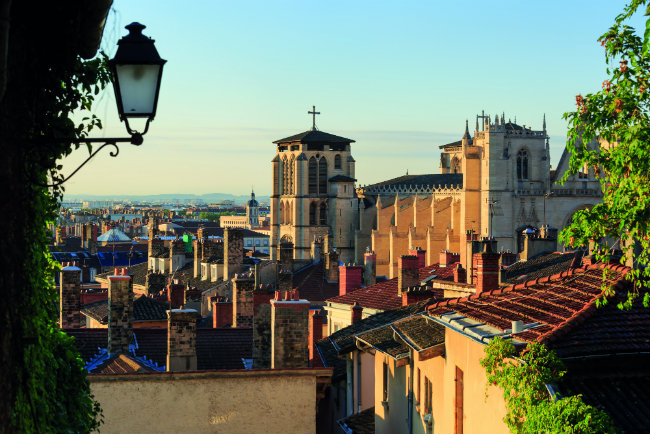
Lyon is the ultimate gastronomic destination. Photo: Shutterstock
I decided to focus on the Drôme, the Ardèche and the Vaucluse, all reliably gorgeous and packed with things to do and places to see. And, as this is one of France’s great wine regions, it made sense to make wine a guiding theme, with side visits to some far-flung spots I’d never seen, like the city of Valence, Chauvet Cave and a secluded eco-resort near Châteauneuf-du-Pape with cabins on a lake (literally). So, with a crazy itinerary in hand, I set off on my adventure.
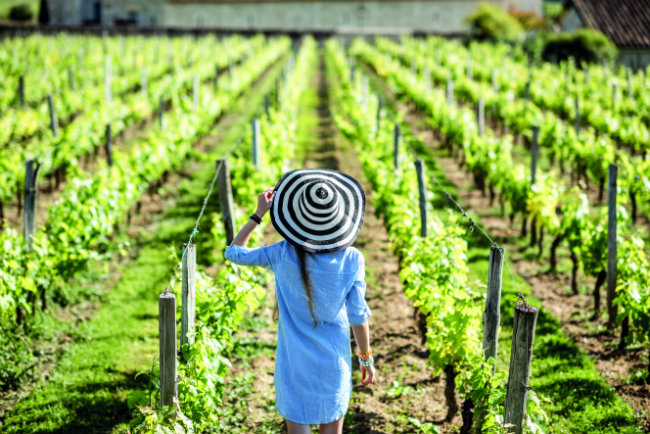
A vineyard tour in the region. Photo: Cave de Tain
With all there is to see here, the Rhône Valley is a place where you can speed up or slow down. Distances are short. You can motor quickly from town to town via the A7 autoroute or the mythical route du Soleil, the N7, which every July for almost a century was clogged with hordes of French holidaymakers on their way south to the coast. Or you can choose a region, or theme – wine and food, Roman ruins, vineyard hikes or biking, for example – and follow narrow country lanes through sleepy perched villages, stopping at your leisure to explore ramparts, a church, a château or a provincial market to sample the local fare.
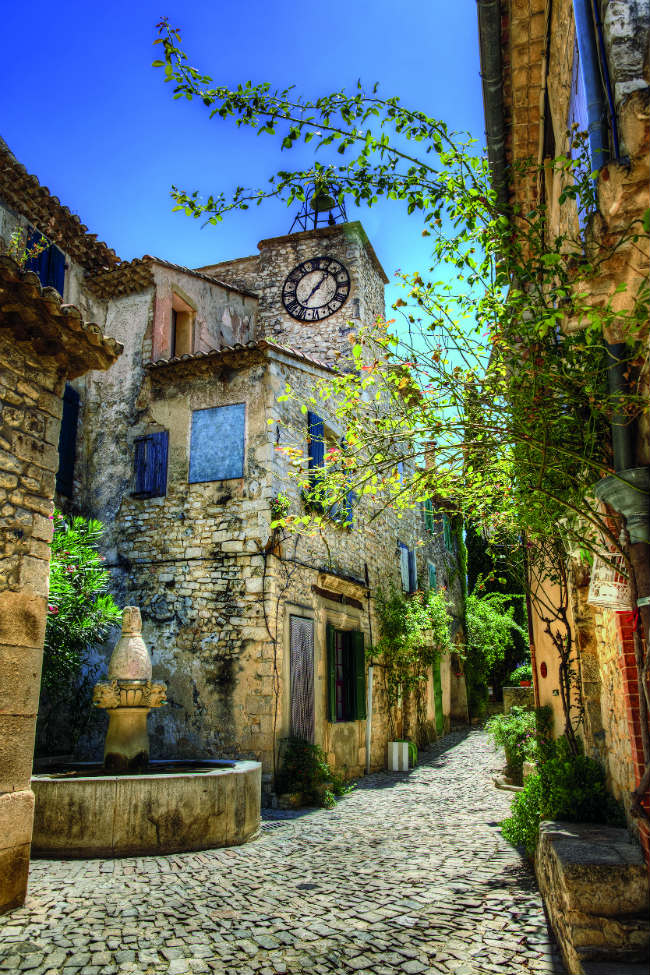
The belfry of Séguret and its one-handed clock. Photo: Shutterstock
CULINARY RESURGENCE
Paris may now own the distinction of ‘gastronomic capital of France’, but Lyon, as the ancient crossroads for the country’s great wines and cuisines, is where the grand French traditions took root. Lyon still nurtures its famous bouchons – family-owned establishments, often in a home and typically headed by women, where the city’s silk workers could get a hearty, reasonably priced meal, washed down with the local vin de Bourgogne. Nowadays, dining here is an exuberant adventure, as Lyon emerges from Paris’s shadow in a scintillating culinary resurgence fuelled by passionate young chefs. The new restaurants are often casual and laid-back, with the emphasis placed squarely on the food. Dinner at Les Apothicaires is the perfect case in point. Here, husband and wife team Ludovic and Tabata Mey create an eight-course “liberated and sincere” menu that plays with textures, temperatures and flavour pairings: the crunch of rose petals and sea salt on beetroot, or white beans paired with smoked eel and velvety cubes of bone marrow and sparks of lemon thyme.
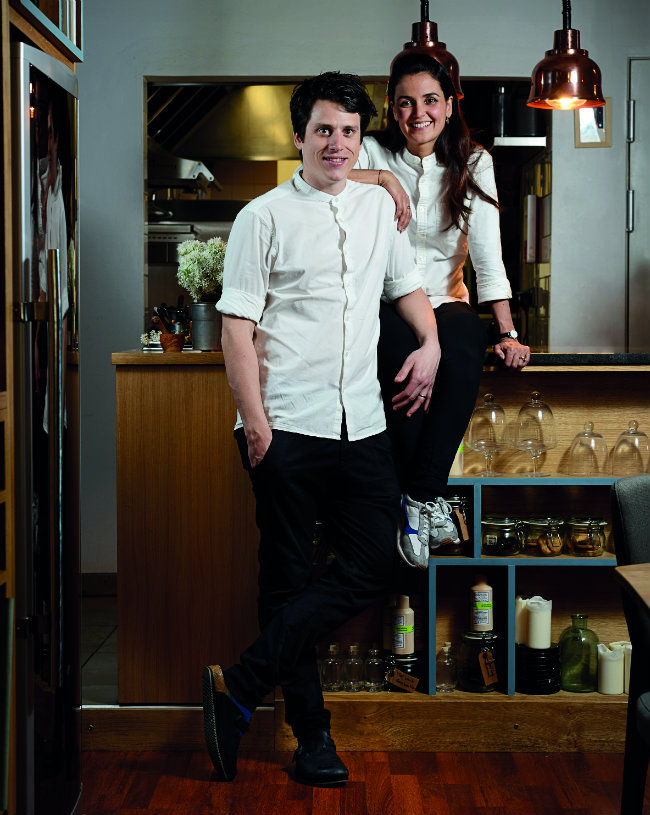
Ludovic and Tabata Mey. Photo: Nicolas Villion
Many of Lyon’s chefs are not native-born but were looking for a less stressful lifestyle than they had in Paris. At Le Kitchen Café, you’ll find Swedish chef Connie Zagora and her pastry chef husband Laurent Ozan, who worked in top kitchens in Paris, Bordeaux and Arles before settling in Lyon. “We were looking for a nice place to live,” they told me. “Lyon is calm, beautiful, and has an airport nearby.” What’s more, “In the last three to five years, Lyon has become one of the most interesting cities for gastronomy”. The restaurant’s gourmet lunch is wildly popular, so you must book ahead.
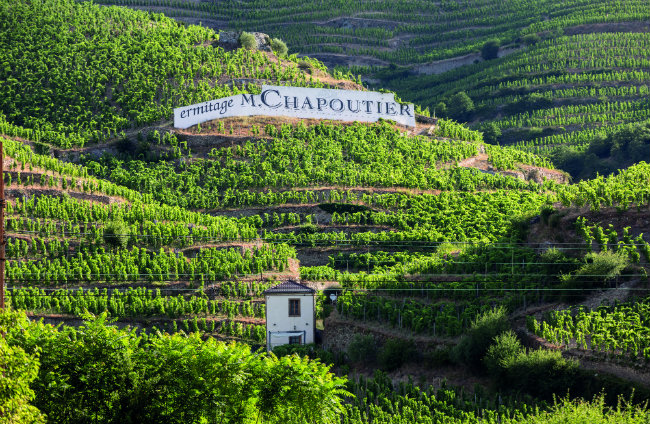
A steep hillside emblazoned with a banner for Michel Chapoutier. Photo: Shutterstock
HILLSIDE VINEYARDS
The steep hillside vineyards bordering the tiny town of Tain-l’Hermitage, on the banks of the Rhône, an hour’s train ride from Lyon, are emblazoned with banners for Michel Chapoutier, Paul Jaboulet and other Côtes du Rhône giants.
A household name in France, Chapoutier is a seventh-generation winemaker whose vineyards cover most of the Rhône Valley, as well as the great Côtes du Rhône appellations lining both sides of the river – Côte-Rôtie, Condrieu, Saint-Joseph, Hermitage, Crozes-Hermitage, Saint-Péray. He is also a pioneer of biodynamic wines, an ecologically-sound method of cultivation that abstains from chemicals and encourages a healthy ecosystem.
Chapoutier is a major presence in Tain-l’Hermitage, with a tasting room and wine boutique and Le Marius Bistro, a fine place for lunch or dinner after your dégustation, all on the main street, a few minutes’ walk from the train station. Tastings are always private and free of charge for up to five people, but you can also participate in one of several workshops offered, pairing wine and food or focusing on Chapoutier’s exclusive grands vins.
The wine cooperative Cave de Tain, whose wines are vying with those of the top producers, will take you on a tour of their winery with explanations of the wines and winemaking process and a tasting afterwards. The sprawling boutique is an excellent place to stock up on wines, which can be shipped anywhere.
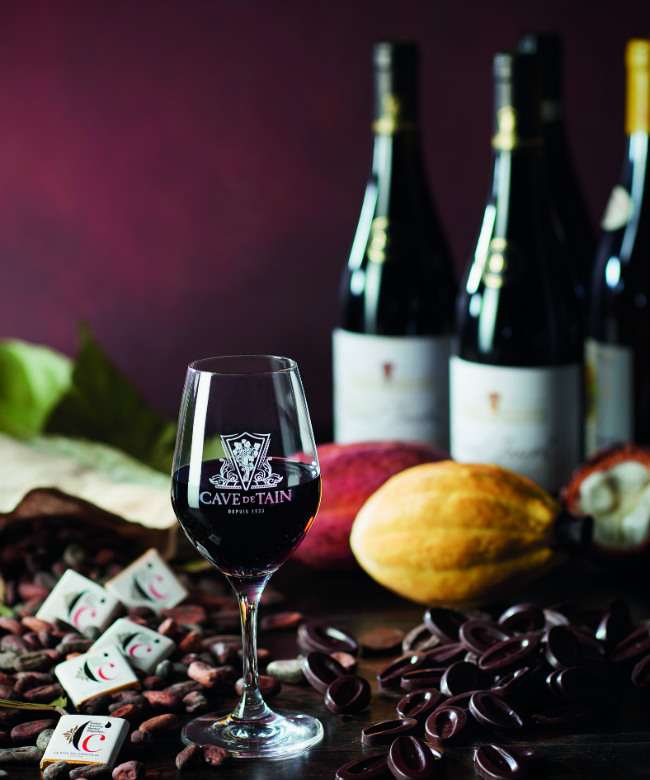
Chocolate and wine at Cave de Tain
Wine and chocolate tastings are on offer at all the major houses, as Tain is also the home of Valrhona chocolate (‘Val’ as in valley, ‘rhona’ as in Rhône), which was founded here in 1922. The globally celebrated brand is France’s number-one premium chocolate and is the one used by most French pastry chefs and chocolatiers.
A chocolate lover’s dream, the Cité du Chocolat excels in interactive activities for adults and kids to discover what chocolate is all about: where it comes from and how to taste and appreciate it – with all the free samples you can eat. Kids and parents can participate in hands-on workshops on chocolate and pastry-making and afterwards dine in the café (on a savoury and sweet all-chocolate menu), and then go crazy in the boutique.
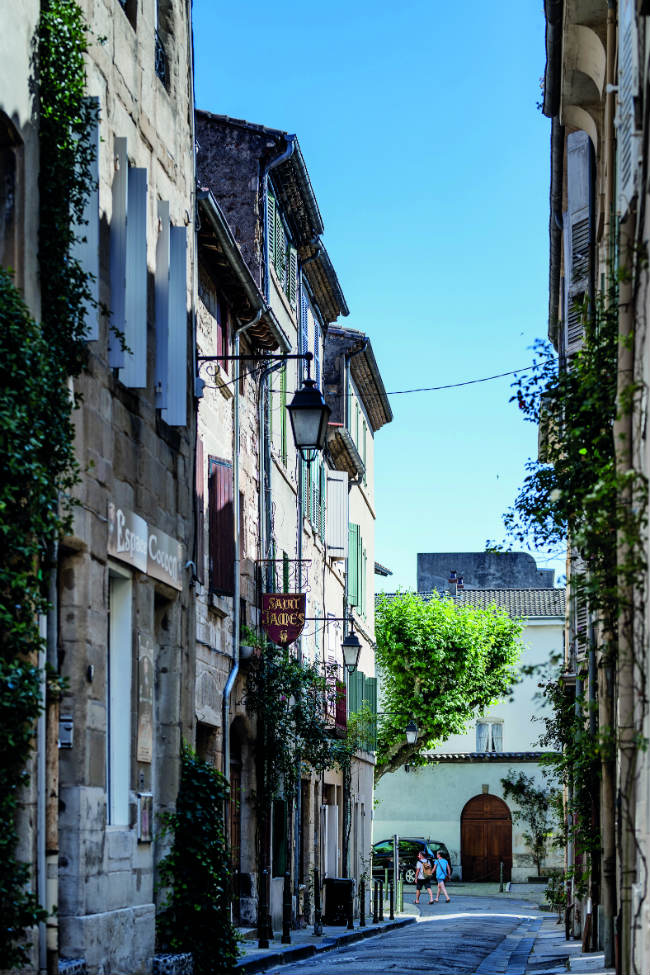
Exploring Valence’s picturesque side streets is a must. Photo: CRESPEAU – Valence Romans Tourisme
CELEBRITY CHEF
Say “Valence” to a French person and they’ll invariably reply, “Anne-Sophie Pic”. Such is the status of this daughter of the Rhône, the only woman in France to hold three Michelin stars and the head of an ever-growing culinary empire. Though Pic now has restaurants in Lausanne, Paris and London, she cooks every night in the kitchen of her eponymous Valence restaurant, a rarity for a celebrity chef, and a major reason to go.
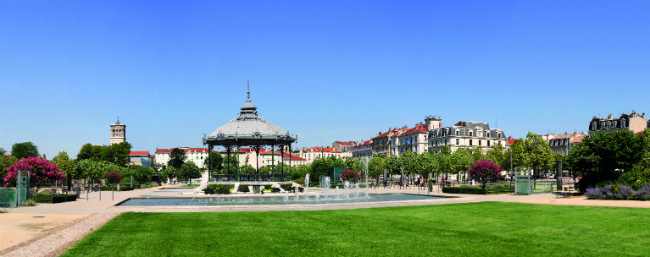
Panoramic view of Valence. ©Valence Romans Tourisme
Pic’s plush gastronomic restaurant, luxury hotel and suave gourmet bistro reside together on an unalluring street in central Valence. This is the restaurant’s historic address; it was opened here by her grandfather in 1936, when the street was on the old N7, so holidaymakers could easily stop in on their way south. Don’t be alarmed by the entrance: to walk through these doors is to enter a parallel universe, complete with luxuriant gardens and elegant hushed rooms that speak of Pic’s 90-year-old legacy as the daughter and granddaughter of legendary chefs. A short way down the street you’ll find Pic’s gourmet épicerie and cooking school, Scook, which offers sophisticated wine and food tastings and classes for all cooking levels.
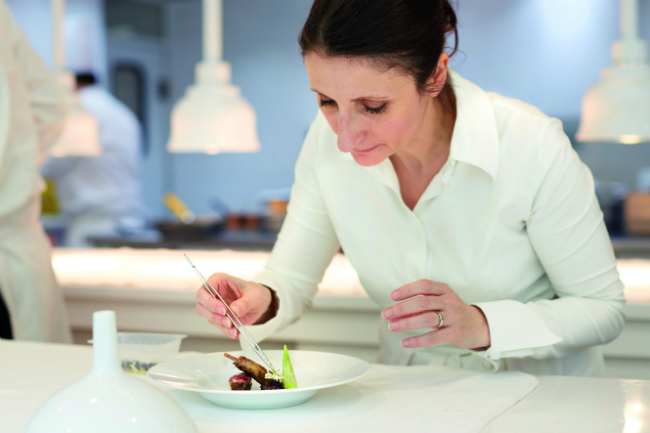
Chef Anne-Sophie Pic
Pic is not the only gastronomic reason to head to Valence. I had one of the best meals of my trip at Flaveurs, where Michelin-starred chef Baptiste Poinot is creating dishes of extraordinary subtlety and sophistication. Poinot’s intimate restaurant is set in Valence’s medieval old town. This is an area well worth an afternoon’s exploration for its cobbled streets lined with Renaissance and medieval buildings, leafy, café-strewn square and market (and local farmers’ market on Tuesday evenings); not to mention the newly-renovated museum offering a fine Roman collection and 360-degree views of the Rhône Valley from its upper terraces.

Montélimar nougat. Photo: Shutterstock
About 30 miles south of Valence, Montélimar, the land of the famous almond-and-pistachio-laden nougat (where you can stop for an hour or two to visit Arnaud Soubeyran’s museum, factory, boutique and café), is called the northern doorway to Provence. The Drôme Provençale, just above Provence’s Vaucluse département, has one of France’s loveliest landscapes, dotted with sleepy medieval villages, vineyards and the foothills of the Alps to the east.
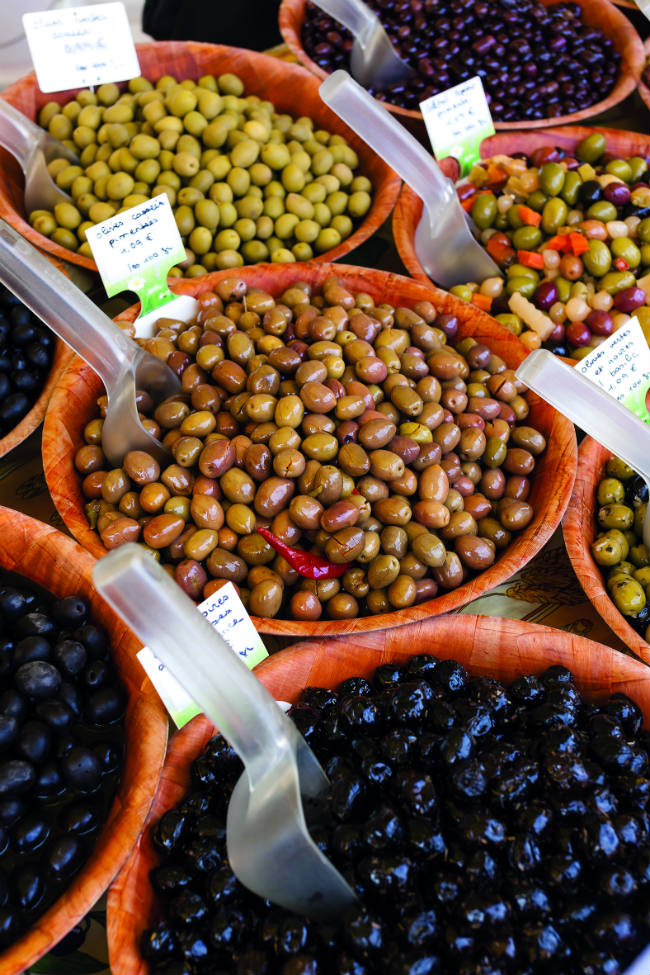
Nyons olives. Photo: Shutterstock
If you have time for just one village in the Drôme, make it Grignan, whose creamy white buildings rise like an apparition above rolling vineyards and lavender fields that explode with colour in late June and July. The Château de Grignan, the beautifully restored 17th-century home of the daughter of Madame de Sévigné, the renowned letter writer, tops the village. Another excellent reason for stopping – and staying – is Le Clair de la Plume, one of the area’s great ‘hotels of charm’, with an outdoor eco-pool, a superb Michelin- starred table and the best breakfast to be had anywhere. Just a bit further inland, the town of Nyons, which is chiefly famous for its deliciously mellow black olives, offers a vibrant farmers’ market and the Vignolis cooperative, where you’ll find all the Rhône’s Grignan-les-Adhémar appellations: Vinsobres, Visan, Suze-la-Rousse and the sparkling Clairette de Die – plus gourmet olive oils and other local specialities.
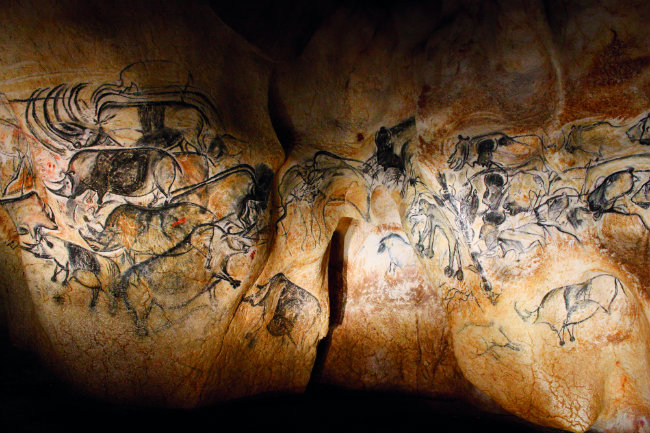
The world’s oldest known prehistoric art at the Chauvet Cave. Photo: ©L. Clara
PREHISTORIC PAINTINGS
In 1994, three speleologists discovered a cave harbouring prehistoric paintings that date back 32,000 years, making these the oldest in the world. Having learned the lessons of Lascaux, which suffered irreversible damage during its 15 years open to the public, Chauvet, which is named after its principal discoverer Jean-Marie Chauvet, was immediately sealed off to all but a handful of scientists and scholars, who are allowed limited access twice a year. It took more than a decade to create Chauvet II, which also benefited from the lessons of Lascaux.
The Caverne du Pont-d’Arc’s wooded grounds were designed to leave the lightest footprint possible on the natural landscape. Once you descend into Chauvet II’s dark interiors it’s easy to forget that this is a facsimile, as the remarkably expressive paintings come vividly to life under lighting meant to recreate the flickering torchlight used by the original artists. It is a moving experience, though the cave itself poses more questions than anyone will ever answer. (Werner Herzog, the only filmmaker to gain a few hours’ access to the cave, made the documentary Cave of Forgotten Dreams – useful viewing before you make your visit.)
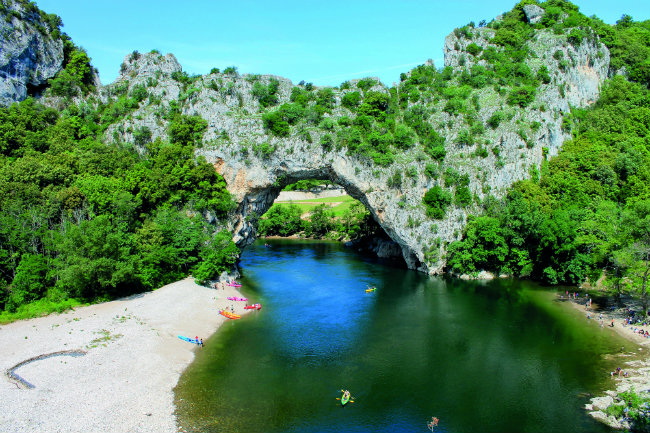
Le Pont d’Arc is a natural formation in the Gorges d’Ardèche, a short distance from the Chauvet Cave. Photo: L. CLARA
From Chauvet II you can visit nearby Pont d’Arc, a natural bridge, and enjoy lunch at the Auberge La Farigoule (be sure to try a red wine and chestnut aperitif and, if you happen by in the winter months, the all-truffle menu, including an omelette, salad and truffle-flecked ice cream). For your perched village x, 12th-century Saint-Montan is a lovely short drive away through scrubby garrigue.
Seventh-generation winemaker Raphaël Pommier and his American wife, Rachel, play up the Chauvet theme with tastings of their award-winning organic wines in a soaring cave near their vineyard in Bourg-Saint-Andéol. Raphaël is an engaging host and raconteur; his passion for the wines and terroir is utterly contagious. Raphaël and Rachel offer a range of local experiences for individuals and families at the vineyard, Notre Dame de Cousignac, plus a restaurant and an adorable B&B. Butting up against the Drôme, across the Rhône from the Ardèche, Provence’s Vaucluse is another département that demands exploration, beginning with Vaison-la-Romaine, a town as famous for its elegant Roman bridge and ruins as for its Tuesday morning market, one of the region’s largest.
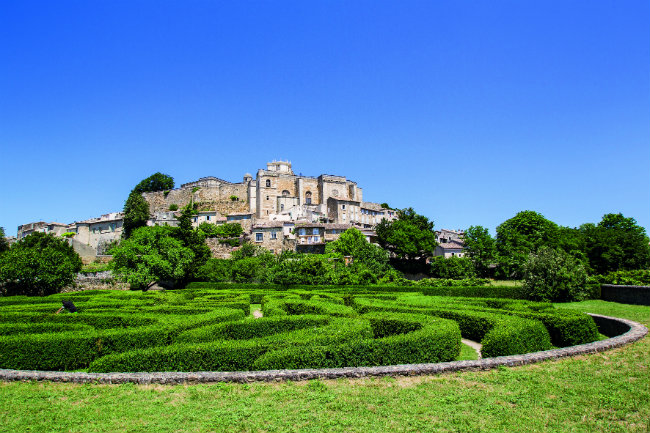
The Château de Grignan, one of the finest in France
Across the jagged Dentelles de Montmirail mountain range begins another, more arid, microclimate whose limestone soils and abundant sunshine produce the gorgeous Grenache-based reds of Gigondas and the sweet Beaumes-de-Venise nectars.
On a four-wheel-drive tour of the terrain above Beaumes-de-Venise, I am reminded once again of why this particular part of Provence grabs my heart: a cloudless, electric-blue sky against the bleached mountains and ruddy gold earth, the leafless black grapevines of late March skewering up with all the fervent life of a Van Gogh painting.
Expertly manoeuvring on this craggy, steep terrain, Claude Chabran, President of the Beaumes-de-Venise cooperative Rhonéa (a great place to taste and buy local wines and other produce), explained how this rocky, upside-down terrain is like no other in the Rhône Valley: “Under the pressure of sediments below, the limestone slabs pushed up vertically, creating the Dentelles. The sediments that were below rose to the surface and the sediments on the surface are now deep. This is the specificity of the region.”
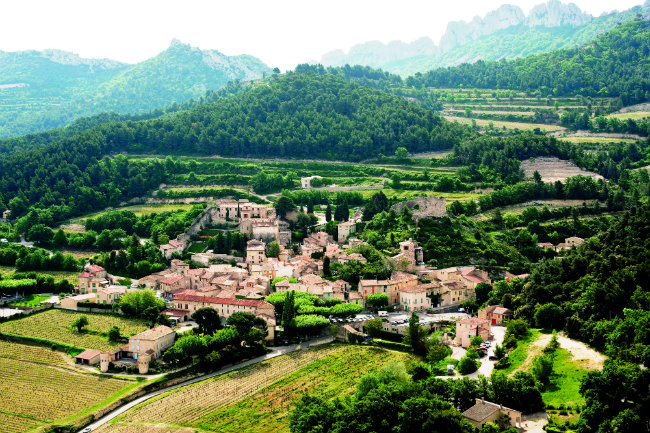
Aerial view of the charming and sophisticated village of Gigonda
DISTINCT CHARACTER
To highlight the uniqueness of each terroir and microclimate – of which there are dozens in the Rhône Valley, varying by such precise factors as elevation, exposure, angle of slope, etc. – at Rhonéa you can taste the distinct character of three red Beaumes-de-Venise from side-by-side terroirs; and, of course, the golden, perfumed Beaumes-de-Venise, a sweet fortified wine made from the Muscat grape, one of the oldest Rhône Valley varietals, beloved of the medieval French popes. A 15-minute drive takes me to the village of Gigondas, a rare mix of charm and sophistication, mostly bestowed by its art gallery and perched tasting room in a medieval stone building, and its superb gastronomic restaurant, L’Oustalet, which won its first Michelin star in February. At an all-truffle lunch with local winemaker Pierre Amadieu, we had the great fortune to sample chef Laurent Deconinck’s exquisite Mediterranean cuisine, including the first asparagus of the season, followed by a sublime dish of melt-in-your-mouth veal and sweetbreads, all complemented by Amadieu’s superb Gigondas reds, whites and rosés.
Gigondas’s lovely shaded square, which embraces L’Oustalet’s outdoor terrace, is the perfect spot to while away an afternoon. The village is also an ideal starting or stopping point for a hike or bike ride along the many vineyard trails, and the town’s central spring provides cool, drinkable water.
It’s worthwhile stopping in at Châteauneuf-du-Pape, about 15 miles away, if only for a tasting at one of the many estates (the highly-respected Domaine Pierre Usseglio, right in town, is a good choice) as well as the Vinadea boutique, where you can taste and purchase the region’s top appellations. Maison Brotte, the wine museum, is also worth a visit for all you need to know about Côtes du Rhône wines.
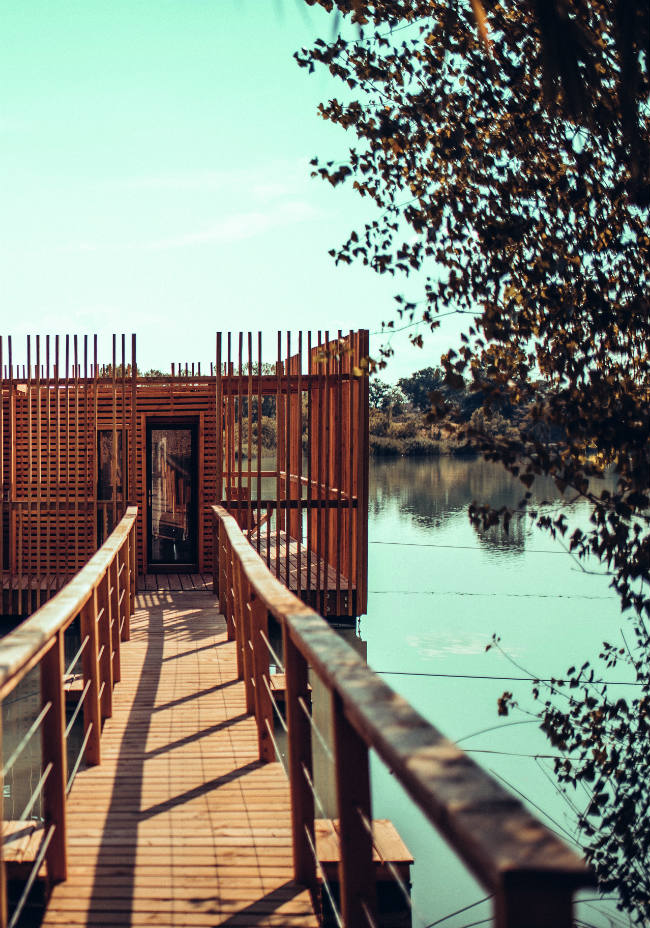
Alternative accommodation at the eco-friendly resort of Coucoo Grands Cépages. Photo: @C. Rodriguez
Arriving at Coucoo Grands Cépages at 6pm was both a blessing (hallelujah, I found it!) and a curse, once I took in the beauty of the place and realised I had about four waking hours to spend there.
Set back off a residential road just outside Châteauneuf-du-Pape, a code gets you through a motorised gate leading to a parking lot where you leave your car and forget about it for however long you have the pleasure of staying.
The resort’s 15 secluded, eco-friendly cabanes, designed for couples or families, are clustered around a lake – two or three are actually on the water, reached by a walkway or boat – and surrounded by tall pampas grass and trees, so you barely see your neighbours. The lake is ringed by a gravel road, and hiking trails take you through the garrigue terrain or to the ozone swimming pool. Breakfast is included in the price and all meals (healthy, Provençal or gourmet; with or without wine) are brought directly to your cabane by golf cart at your appointed hour.
All the cabanes are beautifully designed to best accommodate the Mediterranean climate and offer either a hot tub or sauna. Relaxing on my terrace, watching the sunset over the lake deepen from the colour of an old Beaumes-de-Venise to a fiery fuchsia, seemed like a fitting close to a journey that had served mainly to whet my appetite for more.
SIDEBAR: WHAT TO SEE IN AN AFTERNOON IN AVIGNON
It is best known for its bridge, but I never tire of Avignon, as few small cities in France are as generously endowed. Encircled by the best-preserved ramparts in France and crowned by the Palais des Papes, home of the 14th-century French popes, it’s an all-around impressive sight. Add to that a handful of world-class museums, the incomparable Avignon Theatre Festival and an enviable foodie scene and, well… You see what I mean.
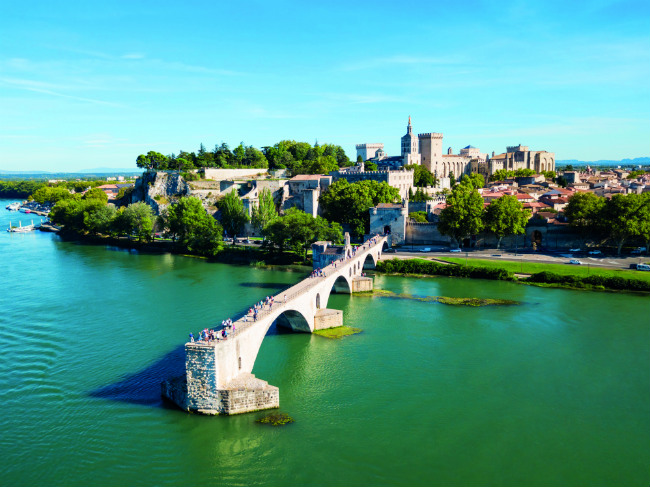
The medieval Pont d’Avignon. Photo: Shutterstock
Wine lovers should head straight to the Carré du Palais, where all the great Rhône Valley appellations are available by the bottle or the glass, paired with meals or delicious small plates of cheese or charcuterie. A few weeks of dining out would not exhaust the gastronomic options here and the overflowing Halles d’Avignon central food market would tempt anyone to rent a farmhouse and dine à la maison.
But with only one afternoon to spend here, I must content myself with a visit to
the Collection Lambert, one of my very favourite contemporary art centres in France, and a walk through the golden-hued old town in the late afternoon light before heading to the train station.
From France Today magazine
Share to: Facebook Twitter LinkedIn Email
Leave a reply
Your email address will not be published. Required fields are marked *

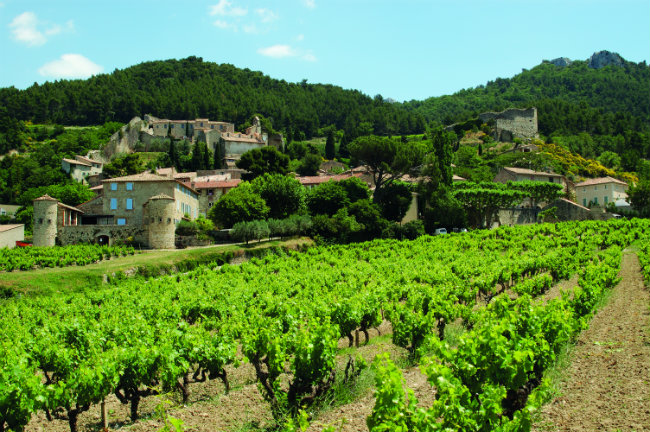




REPLY
REPLY
REPLY
REPLY